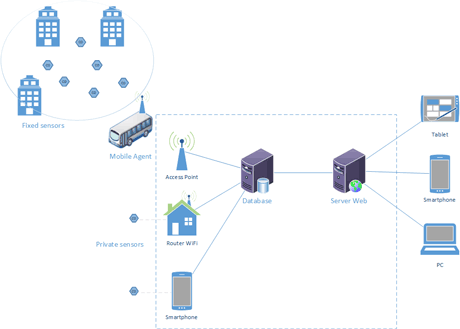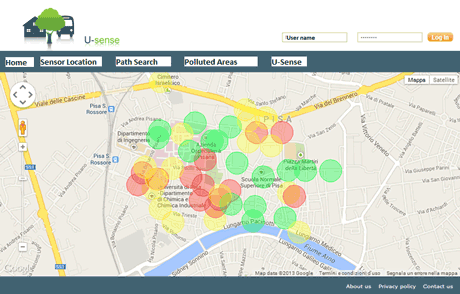by Giuseppe Anastasi, Paolo Bruschi and Francesco Marcelloni
Air quality has a serious impact on public health, the environment and, ultimately the economy of European countries. In this article we present U-Sense, a cooperative sensing system for real-time and fine-grained air quality monitoring in urban areas. U-Sense allows for monitoring to occur in places where people spend the majority of their day-to-day lives.
Air quality continues to be a serious issue for public health, the environment and ultimately, the economy of European countries. Poor air quality results in ill health and premature deaths and damages ecosystems, crops and buildings. Urban areas, where the majority of European’s live, are most seriously affected. In recent years, Europe has significantly reduced the emissions of several air pollutants such as sulphur dioxide (SO2), carbon monoxide (CO), benzene (C6H6) and lead (Pb). However, particulate matter (PM), ozone (O3), nitrogen dioxide (NO2) and some organic compounds still represent a serious threat. The report, “Air Quality in Europe”, published in October 2013 by the European Environment Agency (EEA) [1] describes the effects of air pollution on health, ecosystems and the climate. It also provides an overview of policies and measures introduced in Europe to improve air quality and minimize the impacts of air pollution impacts.
Real-time, accurate monitoring of air pollution levels in urban areas plays a key role in enabling appropriate and timely public health decisions to be made and thus, is of paramount importance. Currently, air quality is typically monitored through large and expensive sensing stations, installed at strategic locations (few) such as intersections. These stations do allow for accurate monitoring but their limited spatial coverage means this information is restricted to specific areas. In addition, the sensing stations are managed by public authorities which means that the pollution data they gather are often not publicly available. Citizens, however, are typically interested in knowing the air quality conditions in places which are relevant to their daily lives such as at home, school, work, or public species.
With this need in mind, we have developed U-Sense, a cooperative sensing system which allows for real-time, fine-grained air quality monitoring in urban areas (Figure 1). U-Sense relies on low-cost sensor nodes, equipped with appropriate gas sensors, which can be privately installed by citizens. The sensor nodes are powered by batteries which allow for flexible deployment and easy relocation. Users can share their measurements using social networking which enables cooperating sensing.

Data transfer can occur in a number of different ways. For example, sensor nodes can be connected directly to the database through a home-based WiFi router. Alternatively, data can be first transferred to an intermediate relay node and then on to the database. This relay node can be the user’s smartphone or, more commonly, any mobile agent (e.g., a mobile relay node mounted on a bus or taxi). The sensor nodes can only transfer their locally acquired data when the relay node comes nearby. Hence, an opportunistic communication protocol is used for data transfer. Data accumulated on the database can be used for providing a number of community services through a variety of different user interfaces (e.g., the Web, smartphone or tablet). The range of services envisaged include access to air quality data measured by individual sensor nodes at any given location, the visualization of pollution maps and search facilities for less polluted paths. The web-based user interface for U-Sense is shown in Figure 2.

The U-Sense project is still in progress. We have completed the software implementation component and we have deployed a number of sensor nodes in across our city (Pisa, Italy). Libelium Waspmote sensor nodes have been used for this testing phase which are equipped with a sensor board that allows for the following air quality parameters to be measured: CO (carbon monoxide), CO2 (carbon dioxide), NO2 (nitrogen dioxide), O3 (ozone), VOC (volatile organic compound), temperature and humidity.
This research activity is being undertaken as part of the “SMARTY” Project, funded by the Regional Government of Tuscany using European funds. The project aims to develop innovative services for sustainable transport and mobility in smart cities. Along with the University of Pisa, the University of Florence and a number of small and medium enterprises are contributing to this project.
Reference:
[1] European Environment Agency, “Air quality in Europe - 2013 Report”, October 2013. Available at: http://www.eea.europa.eu/publications/air-quality-in-europe-2013.
Link:
http://www.iet.unipi.it/~anastasi/
Please contact:
Giuseppe Anastasi
Dept. of Information Engineering, University of Pisa,
Tel: +39 050 2217 559
E-mail:











